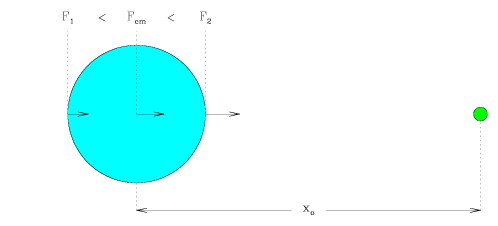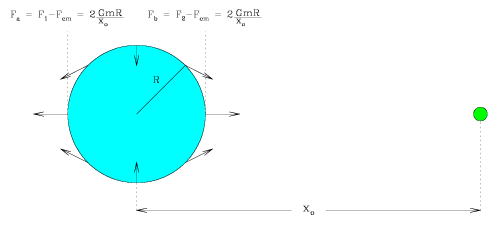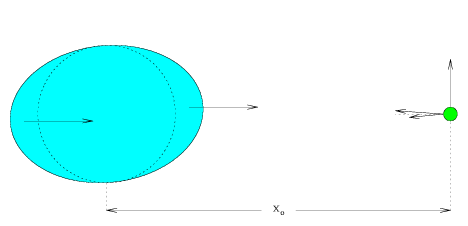
Consider a body of radius R, a distance r0 from mass m. The specific (per unit mass) tidal force is
 |
Along the x-axis which runs through the center of both bodies, we can use a Taylor series to approximate this as
 |
As the tidal force varies inversely with the cube of the distance to m, it varies in amplitude from the far to the near side of the Earth.
 |
| [NMSU, N. Vogt] |
Off of the x-axis, material is drawn towards the x-axis. For a fluid (deformable) body, elongation stretches the body till the surface becomes an equipotential (with a balance of self-gravity, centrifugal, and tidal forces). Both tidal and centrifugal forces act to push the equatorial region outwards, around the globe.
 |
| [NMSU, N. Vogt] |
We focus upon an arbitrary point, and observe the combination of gravitational, centrifugal, and tidal forces producing a total force which draws material from both hemisphere towards the equator.
 |
| [NMSU, N. Vogt] |
The result is an oblate spheroid.
 |
| [NMSU, N. Vogt] |
Within the Roche limit (Hill sphere), tides will prevent rocks from accreting together to form a moon, leaving instead rings composed of small particles.
The Earth's moon is tidally locked (with permanent elongation along one orientation). Because the period of rotation of the Earth relative to the Moon (25 hours) is much less than the orbital period of the Earth-Moon system (29 days), the Earth has two high tides each 25 hours. Likewise, the period of the Earth relative to the Sun (24 hours) is much less than the orbital period of the Earth-Sun system (one year), and the Earth has two solar high tides every 24 hours (of amplitude roughly one-half that of lunar tides). These two tidal cycles are in phase at the new and full moon phases, producing the largest amplitude ties, and also when the Moon is at perigee, and the Earth is at perihelion.
Tidal torques act to transfer energy and angular momentum between bodies.
Moons dissipate energy in the form of heat when deforming; Io is heated in
this fashion (its resonance with Europa holds it in its current orbit), and the
same is true of many satellites with non-synchronous or eccentric orbits.
Angular momentum transfer can cause a moon to spiral outwards (e.g. Luna). We
can express the orbital angular momentum as
 |
where the rotational angular momentum, for a rigid body, is
 |
The kinetic energy of rotation is thus
 |
For a body which is not perfectly elastic, the is a finite response time which causes a lag in the tidal bulge which is raised. For a pro-grade moon with a period of revolution greater than the primary-satellite orbital period, dissipation acts to put the tidal bulges behind the x-axis (lagging in time). Gravity is then no longer a central force, and the torque on the near side of the primary outweighs the retarding torque from the farside bulge. This leads to a positive total torque on the moon, which acquires energy and consequently spirals outwards.
 |
| [NMSU, N. Vogt] |
For a retrograde orbit (e.g. Triton) or one
with an orbital period less than the period of rotation, the moon will spiral
inwards. This torque can be expressed as
 |
where kT is the tidal Love number (a measure of elastic
deformation), Qp is the dissipation factor,  rot is the rotational
angular velocity of the primary, ns is the orbital angular velocity
of the satellite, r is the distance between the two bodies, and the
subscripts p and s refer to the primary and satellite.
rot is the rotational
angular velocity of the primary, ns is the orbital angular velocity
of the satellite, r is the distance between the two bodies, and the
subscripts p and s refer to the primary and satellite.
This effect leads to most satellites being synchronous with their primaries (i.e. the same face always points towards the primary). The Terran year was 400 days long some 350 million years in the past, and even over the last 2,000 years people have measured the length of eclipses and observed a change; 80% of the effect comes from the Moon, and the remaining 20% from the Sun.
Mercury has an orbit of 3 revolutions (days) per two orbits (years). A permanent non-tidal deformation and high eccentricity (0.2) makes a bulge alignment at perihelion efficient from an energy standpoint. The perihelion speed increase puts the angular velocity above the spin rate temporarily. The resulting tidal bulge trails the Sun-Mercury axis and thus gravity acts to speed up Mercury's rotation.